Hyper casualties and what game designers can learn from them
- Transfer
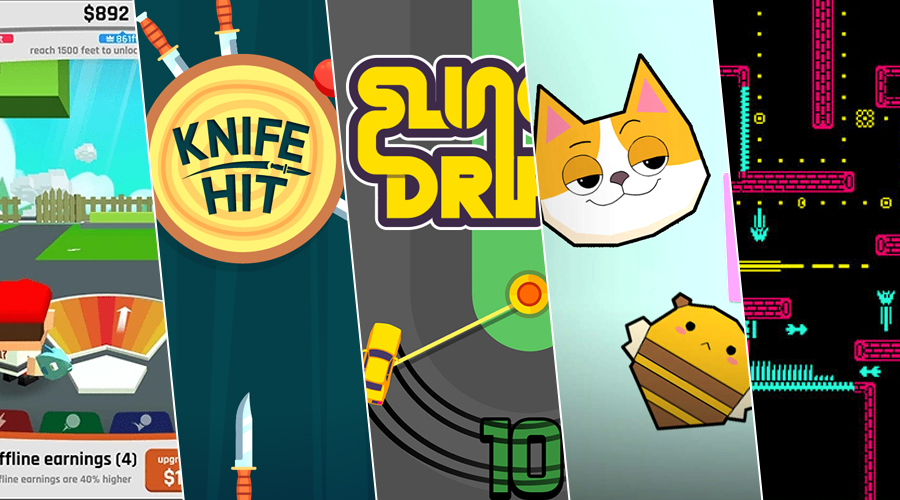
The hyper-casual genre has captured mobile stores. Someone believes that he will die soon, but in the near future this is definitely not destined to come true. Between October 2018 and March 2019, hyper casuals downloaded more than 771 million times.
What makes the genre so successful and is there anything you can borrow from it? Under the cut is a translation of the analysis of game design features that make the genre addictive and popular.
Hyper what?
Hyper-casual is the simplest game with addictive gameplay and minimalistic art, which is usually played only with the help of “tapes” on the screen. They have simple and understandable goals - to score more points, clear levels and so on. Consider this a project developed on game jam, but with the best production quality and meta.
If you (like me) follow the weekly updates of the App Store, then you know that hyper-casuals take over the store. Due to their minimalism and simplicity, developers can spend several months, if not weeks, on development. This is part of the strategy that makes hyper casuals successful. Major publishers of hyper-casual games (Ketchapp, Voodoo, Appsolute Games) release at least one game per week. And people love them - hyper-casuals downloaded more than 100 million times in 2018.
Let me already play this thing!
For simplicity, I will use some of the popular games as examples when exploring various areas of the genre.
Let's start with the opening.
Bored, I leafed through the Instagram feed and discovered Ball Blast for myself - a short 30-second video with the main features made me download the game. The video showed how easy it is to play and win. Started almost instantly - the small size of the game is very important for casual supermarkets.
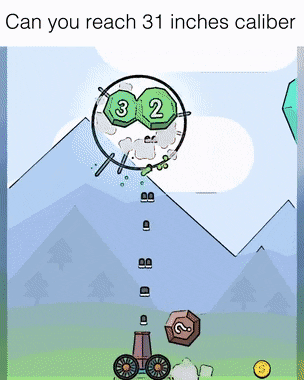
Example of a commercial from social networks
Now about how most users discover these games. Hyper casuales are highly dependent on user acquisition campaigns (User Acquisition) in social networks. If someone browses social networks, then most likely he is just bored. The user is looking for ways to entertain himself, and it is here that these hyper-casuals act as "a knight in shining armor."
The idea is to quickly explain to a potential player that the game is fun and can be started instantly. It is also likely that they are sitting on a smartphone, and nobody likes to download gigabytes (even through good Wi-Fi). From here - you need a small file size.
Ok, the player has downloaded the game and is ready to start. Now what? This brings us to the next topic - onboarding.
The player only needs about 7 seconds to decide how fun the game is and whether to leave it. Such a short period of time means that you do not need a long tutorial and multi-screen UI.
Ball Blast follows these guidelines. As soon as you start the game, you will see a screen with the inscription swipe to shoot - and this is the only tutorial that you will see. Touching the screen, the gun starts to shoot.
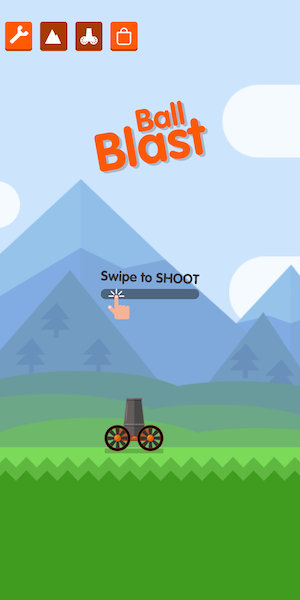
You begin to shoot and understand that the gun can be moved horizontally. When your brain gets used to the “shoot and move” mechanics, a few numbered balls will appear on the screen. You blow them up, they give coins, and large balls break up into smaller ones. Just huh?
The same applies to Ketchapp's Stack game, which immediately loads on the game screen - all you have to do is touch. You will immediately see how the square moves, and that when pressed, it falls on a stack of squares below, and any protruding part is cropped. Because of simple mechanics, tutorials are not needed - the player learns from failures and improves his results. The gameplay is easy to master - just look.
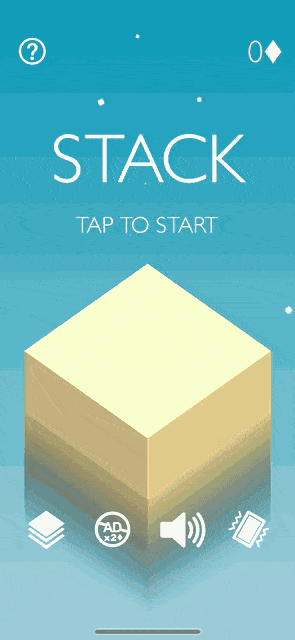
Login and logout
You know how easy and quick you can start playing a hyper-casual game. You take out the smartphone, unlock, click on the game icon, and after a couple of seconds you are already playing.
This is what the brain wants when it is mortally bored. I play a session, feyl a couple of times, set a record and collect rewards. This is a short feedback loop. Successful or unsuccessful actions are reported instantly. In combination with upgrades (which we will talk about later), you will have positive feedback - fascinating and at the same time short.
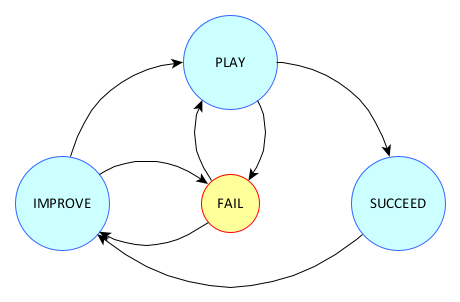
Short feedback loop - the player improves his skills if he loses
If you made a game with catchy gameplay and the players liked it, know that this is probably the only thing they are worried about. Ball Blast lets me into the game as soon as I launch the game, because it understands my needs - an instant pleasure. No user interface transitions, cut scenes and texts. Even if I enter the game in a week, I know how to interact with it, thanks to the simplest mechanics. Entering and exiting a game session is another important aspect that helps to succeed. During breaks I play hyper-casuals - they do not require much time and deep immersion.
Give me all the power
Core gameplay is what keeps the player. It is simple, addictive and a desire to return to the game. What's so fun about shooting multiple balls at Ball Blast? When I first saw the advertisement, I thought: “Okay, this is funny, but will it be fun in a couple of days?”. Answer: "Yes, it will, and still have fun." We are approaching another key point - upgrades.
In Ball Blast, you get gems and coins from the destroyed balls - a kind of “software”. The former are needed to buy cosmetics and do not greatly affect the gameplay, but the latter are used to upgrade the guns. There are four types of improvements:
- Fire Speed: increases the speed of fire.
- Fire Power: Increases Damage.
- Coins Drop: Increases the value and number of falling coins.
- Offline Earnings: increases the number of coins earned in the background.
They all work in synergy to increase your power in the game. For example, the Coins Drop update allows you to collect more coins in one session, which makes it easier to pump the gun - updating a weapon is what makes you feel powerful. This is what makes feedback special - the player feels strong after every game session. And since the player always wants more, he often plays, farm coins and buy upgrades.

The levels are well balanced to maintain this cycle: there are those where you can fully demonstrate your strength, and there are others where the current power is no longer enough and you have to pump it.
Another game that is made on the same principle is Mr. Gun by Ketchapp. You destroy enemies, get coins, and use them to buy new, more powerful weapons. They will quickly give you a premium pistol - this is how the game will explain about upgrades in the form of new weapons and their benefits.
I will take this opportunity and compare this type of hyper-casual with dungeon-crawlers. If you played Diablo or any other dungeon, you will understand. You have the first equipment and weak enemies of the first level, who die from several blows. As you progress through the loot, it gets cooler, and the enemies die from one blow - you feel the power. But here you find yourself in a new location and meet the opponents of the second level. Immediately you realize that your powerful equipment is not so powerful. Do you want to dominate again - and the cycle repeats.
Ball Blast works in the same way, but instead of new equipment, weapons are pumped. And the balance and pace of the levels constantly support the need for improvements.
What if there are no improvements?
Upgrades are cool, but what about games that don't have them? This is a good question.
You know about games where you need to set records among friends - these games rely on a special kind of improvements. Take Stack as the example mentioned above. The player has nothing to upgrade, but the more he plays, the better he gets - he improves his skills. This motivates to play further. And if you make him compete with friends, then everything will become more personal and competitive - another reason to return to the game.
These implicit upgrades allow the player to feel smart or strong and give a sense of progress. The same applies to hyper-casual puzzles, where the player feels smart, solving more and more puzzles that become more difficult over time.

Now there are many hyper-casuals that bet on individual levels, and not on endless gameplay. Each level has something unique with new challenges for the player that generate curiosity and a desire to continue. This is also a great way to convey progression.
Secret ingredient
Until now, we talked about how hyper-casuals attract players through advertising on social networks, hold, attract simple, but addictive mechanics. It's all? Not.
The magical and invisible element to the naked eye is satisfaction (Gratification).
In order to better understand the term in terms of game design, it can be defined as the form of visual / audio / emotional feedback that the player receives after performing any action in the game. And this connection makes actions joyful and meaningful.
Here are some examples:
Notice how responsive Super Meat Boy is? When you press the jump button, the character smoothly goes into an arc, taking into account the inertia (if any), and is accompanied by perfectly synchronized animation. Taking this perfect jump over an obstacle or precipice, you feel satisfaction. Since the game requires fast and accurate movements from the player, the entire game system was designed to please the user.

Housemarque Nex Machina - when a bullet hits an opponent, you get confirmation of a successful hit through a thin white flash over an opponent who dies with a big explosion of cubes and accompanied by suitable sound effects. Killing one opponent already gives a feeling of satisfaction and euphoria, and now imagine the destruction of the boss. Various weapons, enemies and levels delight the player at every moment of the game.

Remember Ball Blast? The movement of the gun, which clearly follows the finger, feedback on the shot at the balls and their decay into smaller ones, the effects of temporary bonuses and upgrades - all these elements work together to provide a pleasant feedback throughout the game.
Another great example is Stack Fall (from Voodoo). You control a bouncing ball: it falls and breaks blocks on its way when you touch and hold your finger on the screen. Splashes of paint, tactile feedback, destruction of blocks - these are some of the elements that bring pleasure and enhance the experience.

Regardless of the action, the player must feel satisfied. Imagine a platformer where a character does not have a landing animation after jumping to convey a change in state or the effects of dust on the ground - it would be strange and boring. And this is not limited only to game actions, you can delight the user through the UI, using context effects and animation. One example is Homescapes. After completing the level, a whole multitude of them appears to emphasize the victory. Even more pleasant when the level is heavy, and it finally manages to pass.

A fascinating game cycle in combination with elements to enhance pleasure is the majority of the factors that are needed to create a fun hyper-casual game.
Conclusion
There was a time when I did not approve of hyper-casual games, there were my reasons: nonexistent art, poor originality, aggressive use of advertising, and so on. He believed that innovative games every week in the App Store are hidden behind a huge stream of hyper-casuals. I am the guy who believes that games are a form of art, a new experience, created with polishing and caution. Perhaps that’s why it will take me years to finish working on my games.
We, as game designers, are proud to develop complex and profound games, but often neglect the simplest. Through hyper-casuals, I drew attention to small details and opened up new perspectives in game development. To summarize the key aspects of the genre:
- A mechanic that doesn't need a tutorial.
- The player’s pleasure from his actions.
- Short feedback loops.
- Ease of entry and exit.
- Feeling of power / intelligence in the form of progression.
- Simple meta to support the main gameplay.
Who knows what awaits us in the future. I don’t know if hyper-casual games will remain, but from them you can already take a few things that will be useful in developing games of other genres.
